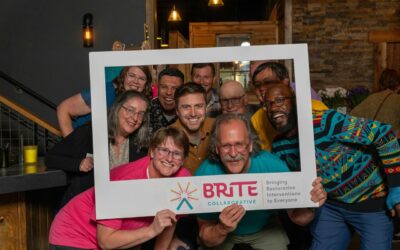Safe Space? Brave Space? Try: Supported Space
Shifting the Burden and Centering The Facilitator’s Role In Community Spaces

Safe Spaces
The term ‘safe space’ was originally used to describe affinity spaces for folks with shared experiences to be in community with one another. Code switching, hypervigilance, explaining oneself – those interpersonal exertions can be left at the door, and exchanged for the ease of understanding that comes from being able to center your (otherwise marginalized) identity. The “safety” touted by those spaces relied on the foundation of having a shared community identity, and a shared understanding.
We can’t wave a safe space wand and do away with power dynamics, with perspective differences, or even bigotry. The current use of “safe space” frequently is used neither to indicate an exclusive community space, nor a true centering of marginalized perspectives and experiences, but, instead, to indicate the abstract desire for a space to have the qualities of Safe Space without the precondition of selective participation. And slapping a ‘safe space’ claim onto a discussion can equate to requesting that marginalized communities be vulnerable in situations that could very well be emotionally risky for them to do so, while also limiting the ability to call it out. We might express that we want a space where people of color can speak openly, honestly, and at ease in a group where white people are present as well. We might hope for a space where queer people can show queer forms of love and expression without fear of violence, amongst straight folks. We might invite a space where undocumented individuals can talk about their safety plans, amongst documented people. We imagine experiences that are accessible across all disabilities and access needs simultaneously, facilitated by folks who are fully able.
Even in a closed space where all share a common identity or experience, can we ever totally prevent harm?
Brave Spaces
This line of inquiry resulted in another popular approach: brave space. Brave space arose from the recognition that most spaces can never truly be ‘safe’ from everything that might be interpersonally damaging or violent, especially as conflict and harm are a regular part of interpersonal interactions.
Be brave and speak truth to power. Be brave and stand up for yourself. What is unearthed in the brave space concept is that participants bear the responsibility of protecting themselves, while being asked to retain an optimism that their peers come from a place of genuine good-faith, even when they say or do something hurtful. This concept succeeds in its honesty around who shoulders the burden in these conversations, but there is reasonable concern around adopting a model that assigns additional labor for those community members who are most at-risk of experiencing harm to begin with.
The bottom line is that the members of our community who experience marginalization, discrimination, legislative persecution, and microaggressions on a daily basis are already always drawing from these wells of bravery and grace for others, essentially paying the emotional tax for their invisible labor. Shouldn’t our mindfully curated spaces reduce that need?
Supported Spaces
As a community, it is necessary to recognize that the environments we create can be life altering, and it is our responsibility to bring each other towards flourishing in them, not disenfranchisement or trauma. To host critically important, difficult, and emotionally impactful conversations and collaborations which do not unnecessarily encumber vulnerable communities, we recommend utilizing a supported space approach.
Supported Space (or supportive space) promises one thing up front – support. And it begs the question: What type of support is available and where will it be coming from? Using this terminology can prompt intentionality on the side of the facilitator, rather than assuming that safety will manifest itself from good intention alone. The benefit of a supported space approach is that each facilitator can discern what tools, resources, and capacities are available to them and their participants, and customize their own structures of support. Creating a supported space is, at its core, more about being open about the support structures you realistically can offer, and allowing participants to make their own choices in terms of safety and bravery.
Announcing a supported space could look something like this: The Gender and Sexuality Center is a space supported by LGBTQIA+ affirming community guidelines, and by staff who are available to chat, address concerns, assist you in accessing campus resources, and ensure that our guidelines are upheld.
This supported space may well create safety, but also doesn’t fall apart if safety is breached. And participants aren’t asked to take on all the work of being brave – we’ve promised support structures with clarity and specificity.
Supported space acknowledges the existence of a temporary community space co-created by the group, and has clearly imposed conduct expectations, boundaries, follow-through, and additional support/complaint mechanisms extended by the facilitator. The facilitator in the room works hard to uphold this agreed upon scaffolding, and uses their power to moderate, mediate, and, sometimes, tactfully enforce it. They may or may not be the person in the room with the most hierarchical or relative power. Primarily, facilitators are charged to divert a certain amount of their energy not just towards the delivery of content or soliciting participation, but to attend to the way in which engagement happens across the group. They are tasked to support the wellbeing of all group members. (It can be ideal to have more than one person working towards these goals on the facilitation side!)
When we anticipate potential support needs, we can, up front, express what we are able to field, and if necessary, what is outside of the scope of the day. And in doing so, we escape the trap of expecting safety to manifest on its own. We remember to create it.
****This short article was written by Amanda Mathew (they/them) and Amelia Gentile-Mathew (she/her). Access the full-text version here. This article has been submitted for publication; we would appreciate authorial attribution if you share or reproduce some or all of this text. Please please do use these ideas freely!
Check Out More Great Articles
A Conversation with BRITE Collaborative
Program SpotlightCCRJP: Will you tell us a little bit about BRITE Collaborative?BRITE Collaborative: BRITE Collaborative is a nonprofit organization...
State RJ Council and CCRJP Announce New Colorado Restorative Justice Practitioner Guidelines
As part of International Restorative Justice Month, the Colorado Restorative Justice Coordinating Council (RJ Council) and the Colorado Coalition...
Home From School: Indigenous Peoples and the Second Harm
Visual from documentary shown at the EventComing together in solidarity, mutuality, with respect for self-determination and sovereignty “This was a...


